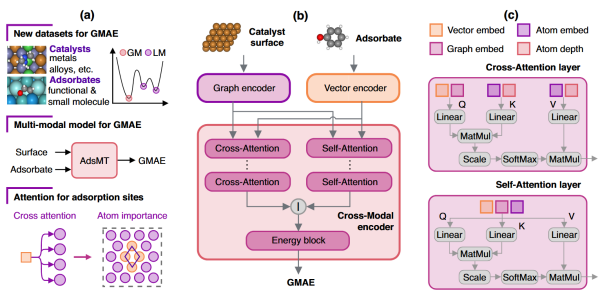A research team led by Associate Professor Yulian He at the University of Michigan–Shanghai Jiao Tong University Joint Institute (UM-SJTU JI, JI hereafter) has published their latest findings in Nature Communications, a top-tier multidisciplinary journal of natural sciences. The study was conducted in collaboration with Professor Philippe Schwaller from the École Polytechnique Fédérale de Lausanne (EPFL), Switzerland.
The paper, titled “A multi-modal transformer for predicting global minimum adsorption energy,” introduces a new deep learning model named AdsMT. This model combines surface graphs and molecular descriptors to accurately predict the global minimum adsorption energy (GMAE), a key indicator of catalyst performance. It offers an efficient solution for large-scale virtual screening of catalysts without relying on adsorption site information.

In catalyst design and high-throughput virtual screening, GMAE is widely used as a key physical quantity to evaluate catalyst activity and selectivity. While Density Functional Theory (DFT)-based methods provide high accuracy, they require the enumeration of numerous adsorption sites and configurations when dealing with complex catalyst surfaces and diverse adsorbates. This leads to high computational costs and low efficiency, which severely hinders the large-scale screening of catalytic materials.
To address this challenge, the team developed a multi-modal Transformer model, AdsMT, which predicts GMAE directly from the catalyst surface graph structure and adsorbate molecular descriptors, without the need for explicit adsorption site information. Compared to DFT calculations, AdsMT improves prediction speed by approximately eight orders of magnitude, and it is about four orders of magnitude faster than machine learning interatomic potential (MLIP) methods that incorporate heuristic search strategies. AdsMT leverages a cross-attention mechanism to learn complex interactions between surface atoms and adsorbates, avoiding the exhaustive enumeration of adsorption structures required by traditional models.
The research team constructed and tested three representative GMAE datasets—Alloy-GMAE, FG-GMAE, and OCD-GMAE—spanning a variety of chemical spaces including metal alloys, functional group adsorbates, and complex inorganic surfaces. AdsMT achieved mean absolute errors (MAE) of 0.09 eV, 0.14 eV, and 0.39 eV on these datasets, outperforming existing graph neural network models. It also achieved a success rate of over 70% in predicting results without requiring adsorption site information. In addition, AdsMT offers strong interpretability, with attention weights that can identify the most probable adsorption sites, aligning well with DFT results.
The AdsMT model represents a significant breakthrough in the application of deep learning in the field of catalysis. It enables efficient, accurate, and interpretable predictions of GMAE without the need for adsorption configuration inputs. This advancement shows great potential to accelerate the discovery of catalytic materials in critical areas such as green energy and CO₂ conversion.
Yulian He and Philippe Schwaller are the co-corresponding authors of the paper. The co-first authors are Xu Huang, a doctoral student from the Chinese team, and Junwu Chen, an EPFL doctoral student. Associate Professor Cheng Hua at the SJTU Antai College of Economics and Management is a co-author.
Author Introduction

Xu Huang holds a bachelor’s degree in Chemical Engineering from Shanghai Jiao Tong University (Class of 2023) and is currently pursuing a Ph.D. in Materials Science and Engineering at the University of California, Berkeley.

Yulian He is an Associate Professor jointly appointed by the UM-SJTU Joint Institute and the School of Chemistry and Chemical Engineering at Shanghai Jiao Tong University. She received her Ph.D. from Yale University. Her research interests include catalyst synthesis and design, C1 catalysis, heterogeneous catalysis, structure–activity relationships, catalytic oxidation and hydrogenation, and data-driven rational catalyst design.





